
Viewing: Blog Posts Tagged with: rosh, Most Recent at Top [Help]
Results 1 - 25 of 27
Blog: Paper Pop-Ups (Login to Add to MyJacketFlap)
JacketFlap tags: studio, statue, wheels, transportation, bicycle, model, ride, petrina case, bespoke, handle bars, girl, Add a tag
Blog: The Children's Book Review (Login to Add to MyJacketFlap)
JacketFlap tags: Ages 0-3, Ages 4-8, Dr. Seuss, Book Lists, Cars, featured, Transportation, Peggy Rathmann, Random House Books for Young Readers, Roy McKie, Greenwillow Books, Sandra Boynton, Annette Tison, Talus Taylor, G.P. Putnam's Sons Books for Young Readers, Donald Crews, Sue Fliess, Family Favorites, Best Kids Stories, Sourcebooks Jabberwocky, Workman Publishing Company, A & P Books, Sarah Beise, Theo. LeSieg, Add a tag
Author Sue Fliess selects "Five Family Favorites" to share with readers ... Read the rest of this post
Add a CommentBlog: The Children's Book Review (Login to Add to MyJacketFlap)
JacketFlap tags: Steve Light, School Bus Books, Anne-Sophie Baumann, Books About Vehicles, Didier Balicevic, Things That Go Books, Ages 0-3, Ages 4-8, Book Lists, Cars, Airplanes, featured, Board Books, Transportation, Trucks, Construction, Yumi Heo, Add a tag
Construction trucks. School buses. Airplanes. You name it, kids can’t get enough of it. Here are a few of our favorite books of Things That Go ... Read the rest of this post
Add a CommentBlog: The Children's Book Review (Login to Add to MyJacketFlap)
JacketFlap tags: Military Stories, Rescue Vehicles, Tony Thatcher, Author Showcase, Transportation, Add a tag
Soldier Ron: Stay close! is the first story of Ron, a trainee soldier in the cadets and the fun and adventures he has trying to follow in the footsteps of his heroes in the military services.
Add a CommentBlog: OUPblog (Login to Add to MyJacketFlap)
JacketFlap tags: Clive Dewey, Indus River, Limits of Western Technological Superiority in South Asia, Steamboats, Steamboats on the Indus, steamships, Books, History, Technology, India, Asia, transportation, 19th century, *Featured, Punjab, british empire, Add a tag
Congratulations on your new posting in the Punjab. Rather than riding eight-hours-a-day on horseback, suffering motion-sickness on a camel’s heaving back, or breaking your back sitting on hard wooden boards in a mail-cart, you’ll be travelling on the Bombay Government Flotilla, one of four flotillas that carry thousands of Europeans and Indians up and down the Indus.
While you may question the expenditure of a government flotilla, we assure you it’s a lot simpler than loading a squadron onto a small fleet of country boats, with indifferent crews, in varying states of repair, which might never reach their destinations. On board we’ll keeping the regiment together arriving as it started out — in one piece and maintaining proper discipline in transit.
So what can you expect on this exciting journey?
1. Expect sun and swelter. Everything you touch will be red hot. You won’t be able to go below in the daytime, but the thin awnings on deck will do little to relieve you in the 115 degree heat. Many soldiers ask whether they should sleep with a berth next to a furnace or choose a wall of heat on deck. With dry winds that come down from the ‘burnt-up hills’, laden with fine sand, everything and everyone will be covered in a layer of fine grey grit. And don’t forget the sand-flies — they bite hard.
2. Expect an uproarious time. Remember that you’re travelling on white man’s mastery of nature, so don’t expect to be the most important thing afloat. Your accommodation will be conveniently crushed between the machinery of furnaces, boilers, pistons, transmission, and paddle-wheels. Passengers trapped in close proximity to the machinery enthuse about the clamour of pistons ‘working up to four or five hundred horse-power’, the splash of paddle-wheels beating the river-water into foam, and the deafening hurricanes when engineers blow off the boiler’s steam ‘half-a-dozen times a day’. And if you’re lucky enough to have the wind blowing in your direction, look forward to being choked by the smoke, singed by the sparks, and splattered by smuts from the funnels.
3. Expect to get intimate with your fellow passengers. When moving to a theatre of war, you’ll be squashed together on the decks ‘like pigs at a market in a pen at night’. Your comrades may jostle to get enough space to lie down; the top of a hatch is a prize reserved for the best bare-knuckle fighter. Never mind about a restless colleague, you’ll be packed so tight in the gaps between the baggage, that once you’re settled down it’ll be impossible to move until the morning.
4. Expect cool nights with fresh dew. As you lay on deck with only a thin cotton awning over your head, gather round the funnel to get a little warmth. Be sure to hang on to your guttery [very thin duvet stuffed with raw cotton] as there will be no great-coats among the soldiers. Not to worry, the women and children suffer most.
5. Expect to be out of your element and out of sorts. Feeling exposed? Living on the open decks for weeks on end in the winter will reduce your resistance to all common Indian diseases. Should you be lucky enough to get an attack fever and dysentery, you’ll lay stretched upon the hard planking without anything under or over you. The sepoys’ conditions, as one would expect, are the best of all. It will be impossible to cross the deck without walking on sick and dying invalids. If they die in the night, they will be ‘instantly thrown overboard’. And after the steamer arrives in the delta, the survivors are off-loaded into sea-going ships destined for Bombay.

6. Expect unbelievable meals. Passengers praise our ‘coarse and unpalatable’ food. Everyone from the boat captains to the cooks have their special arrangements with prices too high for poorer travellers and meals ‘so indifferent’ that passengers who had paid for them refuse to eat them. Even the water is undrinkable! Perhaps your whole regiment will be reduced to foraging in the villages along the banks. Sheep and cows can be bought for a few rupees; Muslim butchers slaughter them; and you can enjoy broiling away till midnight.
7. Expect a tranquil environment. It takes a month or more to get up the whole navigable length of the Indus and they’ll be nothing to see on long stretches of the rivers, except ‘a vast dreary expanse’ of desert stretching out to the horizon, or an endless belt of tamarisk trees running along the low, muddy banks. Many villages are miles from the river to escape the floods, so it’s possible to sail all day without seeing another human being. Throughout the journey you’ll receive small stimulations from a native boat spreading its sail to taking pot shots at the largest living creatures to hand. Never mind the cost of the cartridges: simply steal rounds from the pouches of sick sepoys.
8. Expect a friendly drink or two. Fed up with watching the ‘dreary wilderness’ floating slowly past? Drink yourself stupid. As a hundred soldiers boarded the Meanee en route to the siege of Multan, one of them – delirious from drink – ‘slipped from the men who led him and fell overboard’, a second died of delirium tremens during the voyage, and a third ‘was expected to do so’. En route they ‘lost three or four in the river from drowning’. Worried the military authorities will restrict the sale of alcohol on the boats? Buy country liquor from the villagers – it has roughly the same side-effects.
9. Expect genuine thrills. The most intense excitement on a voyage on the Indus is the occasional shipwreck. Test your phlegm, and proof of national identity. Charles Stewart dismissed the danger of drowning with the utmost nonchalance on his sinking vessel. The really serious inconvenience was the interruption to his meals. React with that much aplomb, and we’ll know you’re British.
10. Expect to see people working together in new ways. Watch every latent animosity in race relations come to the surface. British captains beat Indian pilots every time a boat runs aground; engineers beat the lascars feeding logs into the furnaces if the steam pressure falls; and soldiers beat the cooks if they make a mess of the grub. Passengers straight from England are often shocked.
Remember, in an alien and often threatening environment, it’s worth paying a premium for the reassurance of a European-style cocoon: a steam-hotel, albeit a poor one, gliding along the river while the guests sit on the decks.
Headline image credit: Indus Sunset by Ahmed Sajjad Zaidi. CC BY-SA 2.0 via Wikimedia Commons.
The post What to expect on your 19th century Indus river steamer journey appeared first on OUPblog.
Blog: OUPblog (Login to Add to MyJacketFlap)
JacketFlap tags: Current Affairs, brazil, transportation, FIFA, *Featured, amazônia, Business & Economics, stadiums, Sports & Games, Adam Grossman, Developing Leaders, High-Performance Industry, Sports Strategist, empty seats, empty stadiums, FIFA Fan Fests, integrated place marketing strategy, Irving Rein, major sporting events, marketing challenges, World Cup 2014 Brazil, gabriel_srsmith, fests, ainda, construçao, Books, Add a tag
By Irving Rein and Adam Grossman
Stunning upsets. Dramatic finishes. Individual brilliance. Goals galore. The 2014 World Cup has started off with a bang. Yet, not as many people as expected are on hand to hear and see the excitement in venues throughout Brazil. Outside of the home country’s matches, there have been thousands of empty seats in stadiums throughout the tournament. Even marquee matchups, such as the Netherlands-Spain game, have failed to fill their venues. The Italian and English football associations each had 2,500 tickets allocated for their recent game. While England sold their entire allotment, Italy was reported to have returned hundreds of tickets back to FIFA.
So why is the world’s most popular sporting event playing to empty seats? Hosting the event in Brazil does create unique structural challenges that likely have and will prevent more sellouts. Because of the billions of dollars of public funds spent on the World Cup by Brazil, FIFA allocated a large number of tickets for exclusive purchase by fans from the host nation that are paying the bill. In a country where a 10-cent price increase in bus fare caused a nation-wide protest last year, paying $135-$188 dollars per match is likely too expensive for many Brazilian soccer fans.
However, the World Cup is not alone in having difficulty filling empty seats for major sporting events. For example, the National Football League (NFL) and the Southeastern Conference (SEC) are two of the most popular sports leagues in the United States. Yet, both organizations have seen declines in attendance over the past years and are spending significant resources in addressing this venue challenge. With ticket prices continually increasing and technology making it easing than ever to watch games on your television, laptop, or phone, how do sports organizations get people to come to venues?

Arena da Amazônia – Amazon Arena (Quando ainda em construçao – When still under construction.) Photo by Gabriel Smith. CC BY 2.0 via gabriel_srsmith Flickr.
The 2014 World Cup in Brazil demonstrates many of these issues. One of the biggest place marketing challenges is the location of the stadiums. Both FIFA and Brazil essentially used the Field of Dreams “if you build it they will come” strategy. Brazil decided to build or renovate 12 stadiums in many different parts of the country, including venues in remote locations throughout the country. For example, the United States’ second game will be held in Manaus in the Amazonian jungle. The city can only be reached by boat or plane as no highways connect the city to the rest of Brazil.
Brazil could have focused on eight venues — the minimum required by FIFA to host a World Cup — in locations closer to metropolitan areas. We have found that many of the most successful venues already take advantage of existing infrastructure rather than depending on new development. It is likely that more people would attend World Cup matches if they did not have to rely on new roads, bridges, and rail lines to get there.
Brazil and FIFA have also suffered from the lack of an integrated place marketing strategy. The most forward thinking sports organizations have extended their footprints beyond their venues. FIFA deserves significant credit for extending the World Cup’s footprint beyond the stadiums. For example, FIFA Fan Fests in Brazil are often held on gorgeous beaches in cities where games take place. They are filled with music, television, food, and drink to celebrate the 32 days of the World Cup. This encourages fans from both inside and outside of Brazil to have a World Cup experience without having to attend the games. Millions of people are expected to attend these Fan Fests as they have done in every World Cup since 2002.
However, these place extensions work best when they also encourage people to actually attend the games. In Brazil, the Fan Fests can provide a better overall experience than going to the stadiums. Because many of the stadiums were completed only days before the World Cup started, they lack many of the amenities that are found at the Fan Fest. For example, Arena Amazonia in Manuas will only feature “restaurants and underground parking.” That hardly compares to the festive experience at a Fan Fest. Attending a Fan Fest also does not require buying a ticket or dealing with the traffic problems that occur when traveling to stadiums, and people can still see the game on large television monitors with thousands of other fans. Why attend a game when you can have a better and cheaper experience at a Fan Fest?
The World Cup in Brazil shows that thrilling competitions alone do not fill empty seats. Creating an integrated strategy requires a complete analysis of all factors that would prevent a fan from coming to a venue. This includes examining transportation, accessibility, and technology issues – and making certain that game attendance is not negatively impacted by efforts to engage fans through place extensions.
Adam Grossman is the Founder and President of Block Six Analytics (B6A). He has worked with a number of sports organizations, including the Minnesota Timberwolves, Washington Capitals, and SMG @ Solider Field, to enhance their corporate sponsorship and enterprise marketing capabilities. Irving Rein is Professor of Communication Studies at Northwestern University. He is the author of many books, including The Elusive Fan, High Visibility, and Marketing Places. He has consulted for Major League Baseball, the United States Olympic Committee, the National Aeronautics and Space Administration, and numerous corporations. They are the co-authors of The Sports Strategist: Developing Leaders for a High-Performance Industry with Ben Shields. Read previous blog posts on the sports business.
Subscribe to the OUPblog via email or RSS.
Subscribe to only business and economics articles on the OUPblog via email or RSS.
The post World Cup plays to empty seats appeared first on OUPblog.
Blog: The Children's Book Review (Login to Add to MyJacketFlap)
JacketFlap tags: Ivan Earl Aguilar, Overcoming New Challenges, Paul E. Hohmann, Travel, Picture Books, Pilots, Airplanes, Author Showcase, Transportation, Add a tag
The Children’s Book Review | May 21, 2014 The Tale of Tango By Paul E. Hohmann; Illustrated by Ivan Earl Aguilar Paperback: 24 pages Age Range: 4-8 Publisher: XLIBRIS (February 20, 2014) ISBN: 978-1493163687 What to expect: Airplanes, Pilots, Overcoming New Challenges The Tale of Tango is an illustrated story of one little plane’s life journey […]
Add a CommentBlog: The Children's Book Review (Login to Add to MyJacketFlap)
JacketFlap tags: James Dean, Daddy Books, Giveaways, Book Giveaway, Fathers, Transportation, Father's Day, Trucks, Construction, Joan Holub, Add a tag
Enter to win an autographed copy of Mighty Dads, story by award-winning author Joan Holub and illustrations by James Dean, creator of the bestselling "Pete the Cat" books. Giveaway begins April 15, 2014, at 12:01 A.M. PST and ends May 14, 2014, at 11:59 P.M. PST.
Add a CommentBlog: (Login to Add to MyJacketFlap)
JacketFlap tags: shapes, transportation, chieu anh urban, Away We Go!, A Shape and Seek Book, cream studio, Add a tag
Blog: (Login to Add to MyJacketFlap)
JacketFlap tags: chieu anh urban, Toddler Approved, shapes, preschool activities, transportation, Add a tag
 |
| Photo courtesy of Toddler Approved. |
 |
| Photo courtesy of Toddler Approved |
Blog: Kid Lit Reviews (Login to Add to MyJacketFlap)
JacketFlap tags: library, pirates, Children's Books, reviews, family, picture book, relationships, humor, children's book reviews, entertainment, picture book reviews, transportation, gold, Flashlight Press, booty, be yourself, bounty, 4stars, Library Donated Books, pirate ships, buccaneers, Carrie Clickard, land lubber, Mark Meyers, ship's cook, Add a tag
…………………… Victricia Malicia: Book-Loving Buccaneer Carrie Clickard, author Mark Meyers, illustrator 4 Stars ………….. Inside Front Jacket: Victricia Malicia Barrett may have been born on a pirate ship and raised in all the best pirate ways, but she sure is a wreck on deck. Her knots slip, she falls from the rigging, and rats abandon [...]![]()
Blog: The Children's Book Review (Login to Add to MyJacketFlap)
JacketFlap tags: Trent Reedy, David Clemesha, Ages 0-3, Ages 4-8, Ages 9-12, Trains, featured, Transportation, Trucks, Brian Biggs, William Low, Andrea Zimmerman, Steve Light, Add a tag
By Nina Schuyler, The Children’s Book Review
Published: August 9, 2012
What is it about boys and wheels? Yes, I’m making a gross generalization and relying far too heavily on anecdotal evidence, but I don’t see our neighbors with daughters outside at 6:30 am on Garbage Day, watching the parade of garbage trucks go by. All to the delight and squeals of my 14 month old son, a son who bolts up in bed when he hears the first rumble of the trucks. A son whose bedroom rug is decorated with things that go– airplanes, fire trucks, cars, trains, and helicopters—and it is the wheel, that black round object, to which he points and drools.
In honor of boys and things that go, here are a handful of new books that celebrate the wheel.
Picture Books
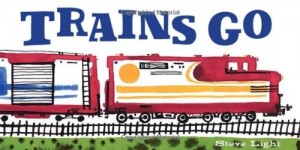 Trains Go
Trains Go
By Steve Light
Steve Light, the author and illustrator of Trains Go knows the allure of trains. It’s not just the rattle and clang or the choo choo or whoosh, it’s the length. How the train just keeps going by, car after car, as if it will never end. Light uses watercolor and black ink and beautifully illustrates trains –freight and diesel and speed and more. When you open the page, the train stretches to two feet. That’s a lot of train!
Ages 1-5 | Publisher: Chronicle Books | January 25, 2012
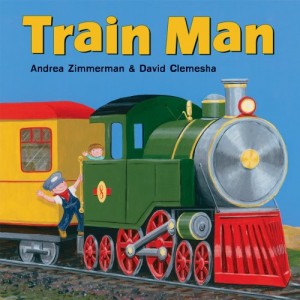 Train Man
Train Man
By Andrea Zimmerman and David Clemesha
In Train Man, by Andrea Zimmerman and David Clemesha, we enter the realm of a boy’s imagination as he considers what he’ll be when he grows up. A train man, without a doubt, with a train man hat and overalls. As the story progresses, his toy train turns into a big engine and he is at the helm, traveling up the mountain and back down again, then finally into his room with his track and miniature trains.
Ages 2-5 | Publisher: Henry Holt and Co.| March 13, 2012
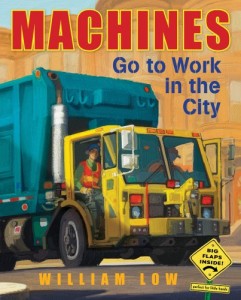 Machines Go to Work in the City
Machines Go to Work in the City
By William Low
Since I received this book a couple weeks ago, my son has picked it up probably fifty times. (You’ll see why in a second). William Low’s Machines Go to Work in the City opens with a garbage truck. “Vroooom! Here comes the garbage truck, making its run! When the truck makes its last pickup, are the garbage collectors done for the day?” The page on the left folds out or up or down to give you the answer: “No, they must go to the landfill to empty the trash.” (And then I launch into a discussion of how we want to try to recycle because look at that yucky landfill. Never too early to start, I suppose). That’s the pattern of the book as it moves through commuter trains, vacuum trucks, tower cranes and airplanes. After the umpteenth reading, my son now says very clearly and distinctly the word, “No.”
Ages 2-6 | Publisher: Henry Holt and Co.| June 5, 2012
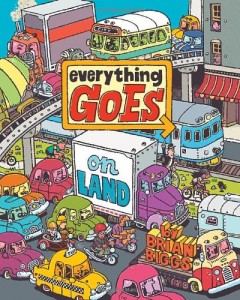 Everything Goes On Land
Everything Goes On Land
By Brian Biggs
Everything Goes On Land by Brian Biggs illustrates the entire page, using lots of color and capturing the sense of a city with its busyness and packed streets. We move through the city with a little boy and his father, who is driving. They see cars, trucks, RVs, bikes, buses, motorcycles, subway and trains. The book is interspersed with detailed explanations about particular vehicles. We even get to learn about how an electric car works. Biggs has a wonderful sense of the silly, letting the dogs and birds talk. He’s also built in a sort of I Spy game with birds wearing hats and random things that just don’t belong.
Ages 4-8 | Publisher: HarperCollins | September 13, 2011
A Chapter Book
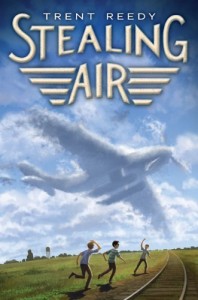 Stealing Air
Stealing Air
By Trent Reedy
Trent Reedy in Stealing Air has a keen sense of what might appeal to a young boy– not only things that go, but boys who build rocket bikes and real airplanes in secret sheds.( Yes, a bike that with a flip of a switch zooms down the road.) Brian, a newcomer to Iowa, makes friends with Max, who shares with him his secret—in a hidden shed, he’s building a real airplane that looks like a flying motorcycle. But Max is afraid of heights so he solicits help from Brian and Alex, the popular kid from school, to serve as pilot and co-pilot. If the plane is ever to get off the ground, the boys have to overcome fights at home, at school, and a bully named Frankie.
Ages 8-12 | Publisher: Scholastic, Inc. | October 1, 2012
Nina Schuyler’s first novel, “The Painting,” was nominated for the Northern California Book Award and was named a ‘Best Book’ by the San Francisco Chronicle. Her next novel, “The Translator,” will be published by Pegasus Books in New York, Spring, 2013. She is the fiction editor for www.ablemuse.com and teaches creative writing at the University of San Francisco.
Original article: Kids Car Books & Things That Go: Airplanes, Fire Trucks, & Trains. Oh, My!
©2012 The Childrens Book Review. All Rights Reserved.
Add a CommentBlog: The Children's Book Review (Login to Add to MyJacketFlap)
JacketFlap tags: Travel, Ages 0-3, Cars, ABC's, Maria van Lieshout, Transportation, Featured Videos, Add a tag
Reading level: Ages 1-4
Add this book to your collection: Backseat A-B-See
Video courtesy of ChronicleBooks: Vroom! Vroom! From the backseat, what do you see? Whether on a cross-country road trip or a quick jaunt across town, there’s no end to what a child can see from the backseat of a car. Using familiar road signs, this striking book introduces little ones not just to the alphabet but also to the world around them. Equally perfect for transportation-obsessed children and those just learning to read, this fresh and dynamic picture book will entertain and educate at home, in the classroom, and on the go.
Maria van Lieshout is the author-illustrator of several picture books whose “loosely drawn pen and ink illustrations…wring Oscar-winning expressions from the slenderest curves and squiggles” (Publishers Weekly). She was born and raised in Holland and now lives in San Francisco
©2012 The Childrens Book Review. All Rights Reserved.
. Add a CommentBlog: wonkyworks (Login to Add to MyJacketFlap)
JacketFlap tags: Elephant, Rabbit, Transportation, Invention, Add a tag
Blog: Brimful Curiosities (Login to Add to MyJacketFlap)
JacketFlap tags: Scholastic, Birthday, Transportation, 2011, Book Review, Picture Books, Gifts, Toys, Add a tag
When passing by all the toys on the store shelves, do you ever wonder about where they were made and where they'll end up? Just think of all the stories toys could tell! From the factory, to home, to an attic or basement and beyond, tracing the journey of a toy is an interesting thought. Walter Wick takes readers on the life journey of a toy train in his newest picture book, Can You See What I See? Toyland Express. Can You See What I See?: Toyland Express: Picture Puzzles to Search and Solve
Can You See What I See?: Toyland Express: Picture Puzzles to Search and Solve by Walter Wick. Scholastic / Cartwheel Books (October 2011); ISBN 9780545244831; 40 pages
Book Source: Review copy provided by publisher
Wick is a genius at creating and capturing incredible, imaginative scenes -- so many fabulous trinkets and toys are all captured in his photographs. The beauty of a Walter Wick search and find puzzle book lies in the dizzying variety of objects and the impressive sets. What my kids wouldn't give to live in his studio and play with all those elaborate sets!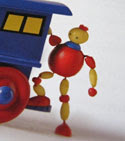 Like Wick's other books, Toyland Express is full of all sorts of delightful finds. Besides the Toyland Express train, readers get a chance to search for more than 250 hidden objects in this fun, photographic adventure that portrays the life of a little blue toy train. The train is created and painted in a workshop. Then it goes from store window display on to become a beloved birthday gift. Later, forgotten in the attic, it finally ends up in a yard sale and finds another loving home. The toy train storyline unites all the photographs in the book and gives the book an interesting fictional depth.
Like Wick's other books, Toyland Express is full of all sorts of delightful finds. Besides the Toyland Express train, readers get a chance to search for more than 250 hidden objects in this fun, photographic adventure that portrays the life of a little blue toy train. The train is created and painted in a workshop. Then it goes from store window display on to become a beloved birthday gift. Later, forgotten in the attic, it finally ends up in a yard sale and finds another loving home. The toy train storyline unites all the photographs in the book and gives the book an interesting fictional depth.
Toyland Express is the first Can You See What I See? series book my family has read, though we've read many of his I Spy books together. We really enjoyed watching the story of a toy train unfold in the photographs. We also learned about a new-to-us Wick character, a "bead boy" named Seymour! Seymour is a cute character that Wick hides in all the Can You See What I See? books. (Here's a little fun tidbit: Seymour is *gasp* "naked" (devoid of paint) in parts of the Toyland Express book!)
Blog: Brimful Curiosities (Login to Add to MyJacketFlap)
JacketFlap tags: Christmas, Toys, Wordless Wednesday, Transportation, Christmas gifts, Add a tag
(Note to Santa: Please remember to take the toys out of the package and make sure they work before delivering them on Christmas Eve.)
Our tree is up! Underneath the tree my son's Geotrax Christmas train makes its rounds. He received the train last year as a present from Santa. Santa must have forgotten to do a final quality check because he delivered a non-working train - a dud! Those elves need to do a better job making the toys! Luckily my son didn't seem to mind in the least and played with it manually. Oh, to be a innocent young child, glad for all gifts, even non-working ones! Even so, a few weeks later Santa had a new, working train delivered to our home. We're enjoying watching and listening to it chug around our tree this year and hope it continues to work year after year after year.
Find more of this week's Wordless Wednesday (or Wordful) posts at 5 Minutes for Mom.
Blog: Brimful Curiosities (Login to Add to MyJacketFlap)
JacketFlap tags: Crafts, Transportation, Balzer + Bray, 2011, Book crafts, HarperCollins, Book Review, Picture Books, Add a tag
Perusing the library with my son never fails to entertain. He has very specific criteria in mind when it comes to choosing books. Basically anything with a train, car, airplane or other vehicle on the cover will garner his approval. Does this selection method hold true for all preschool-age boys? I don't know, but judging from the ragged condition of the transportation themed books in our library, I'd say this subject is very popular with little boys and quite possibly with little girls as well.
Since we've devoured nearly every transportation book in the library, we're always on the lookout for the latest and greatest zooming, zipping, chugging, or digging book. Enter Brian Biggs and his new Everything Goes picture book. My son's reaction? Love at first sight! Everything Goes: On Land
Everything Goes: On Land by Brian Biggs. Balzer + Bray / HarperCollins (September 2011); ISBN 9780061958090; 56 pages
From cover to cover, Everything Goes: On Land is chuck full of cars, trucks, bikes, trains -- tons of land-going city vehicles. Eye-catching and completely riveting for all transportation book aficionados, Biggs doesn't leave anything out in his jam-packed, cartoony illustrations. Even the odd, not oft seen vehicles make an appearance. Double Decker Bus. ✔ Elevated Train. ✔ Penny-farthing. ✔ Bird with a hat. ✔ (No, that's not a typo. There really are birds with hats. What's that got to do with vehicles? I have no idea, but the birds are pretty silly and appear in all the city pictures along with a lot other out-of-place things! Channeling Richard Scarry and Goldbug, perhaps?)
This is the kind of seek-and-find book one could easily stare at for hours, days, and not see everything, and there's also an interesting storyline weaving through the book about a little boy to consider. Henry drives into the city with his dad to a surprise location and the two talk [via speech balloons] about all the vehicles they see along the way, discussing some in great detail.  Through a number of simple vehicle diagrams, the reader learns along with Henry about the interworkings of a car, tractor-trailer rig, RV, bicycle, and motorcycle. To add to the educational experience, Everything Goes: On Land also works as a challenging counting book. Readers can count one-by-one to 100, searching for each number in order.
Through a number of simple vehicle diagrams, the reader learns along with Henry about the interworkings of a car, tractor-trailer rig, RV, bicycle, and motorcycle. To add to the educational experience, Everything Goes: On Land also works as a challenging counting book. Readers can count one-by-one to 100, searching for each number in order.
The side-stories are quite amusing
Blog: the enchanted easel (Login to Add to MyJacketFlap)
JacketFlap tags: bedding, nursery art, the enchanted easel, cute, boys, airplanes, whimsical, transportation, aviation, Add a tag

these cute little airplanes are FOR SALE here:
http://etsy.com/listing/82260599/airplane-nursery-art-set-originals
they are made to coordinate with today's popular beddings. and...just because i love to decorate little boy's rooms:)
Blog: The Children's Book Review (Login to Add to MyJacketFlap)
JacketFlap tags: Ages Four to Eight: Books for Pre-School Through Second Grade, I Spy, Transportation, Trucks, Brian Biggs, Featured Videos, Add a tag
Add this book to your collection: Everything Goes: On Land
Have you read this book? Rate it:
Note: There is a rating embedded within this post, please visit this post to rate it.
©2011 The Childrens Book Review. All Rights Reserved.
. Add a CommentBlog: Shelf-employed (Login to Add to MyJacketFlap)
JacketFlap tags: book review, nonfiction, series, trains, Non-Fiction Monday, transportation, E, Add a tag
Blog: The Spectacle (Login to Add to MyJacketFlap)
JacketFlap tags: transportation, Joni Sensel, Add a tag
I’m writing a sci-fi YA that involves an (only slightly) unusual means of transportation that I happen to know fairly well, so I’ve been thinking about wheels and rides. A lot of spec fic uses some pretty ordinary means of getting from one place to another. Many dystopias rely, for obvious reasons, on feet. But one of the the things that really captured my imagination about the movie MAD MAX, back in the day, was the creators’ vision of what would happen to wheels (and planes) in a gas-constrained, post-apocalyptic world.
I don’t think I recall anyone ever much addressing transportation diversity, or the relative lack thereof, in our genre. (Free MFA project idea, right here. All yours!) It seems to me like an area ripe for some creative author to strike gold. There are oodles of:
- Space ships and rockets with assumptions but not much detail behind them.
- Wagons and creature-back riding.
- Any number of portals (though most are mere doorways, not a means to get anywhere you’d like to go).
- Your classic magic carpet, I suppose.
But I can think of fewer really inventive ways to get around in books that I’ve read. I think that’s one reason books or plot elements on the way other end of the spectrum, such as HOWL’S MOVING CASTLE or the quidditch broomsticks, can really make a splash.
What’s your favorite clever or creative mode of transportation from a spec fic book or movie?
![]() — Joni, who will always have a soft spot for walkers, critter-riding, and things that go fast
— Joni, who will always have a soft spot for walkers, critter-riding, and things that go fast
Filed under: Joni Sensel Tagged: transportation
Blog: sruble.com (Login to Add to MyJacketFlap)
JacketFlap tags: fun, illustration friday, drawing, if, transportation, flying, my art, children's books, art, chickens, digital, fun stuff, Add a tag
The prompt for Illustration Friday this week is transportation. If you could travel any way you wanted, what mode of transportation would you choose? I’d pick something fun, like flying by paper airplane, if it were possible.

Paper Airplane Night Flight
Jumping out of the airplane might be fun too …

Parachute Chicken
… as long as your parachute opens! Eep! Maybe I should stick to something closer to the ground, like skateboarding.

Skateboarding Chicken
Then again, since I don’t have a skateboard anymore and I’m not a chicken, I’ll pick something I do on a regular basis.

Fun While Grocery Shopping
But only until they invent paper airplanes that you can fly in. What kind of transportation would you choose, if you could choose anything? Have you ever had grocery cart races? (I have!)
Blog: Ginger Pixels (Login to Add to MyJacketFlap)
JacketFlap tags: children's book illustration, boy, dog, Ginger Nielson, skateboard, transportation, Add a tag

Blog: Kids Lit (Login to Add to MyJacketFlap)
JacketFlap tags: Book Reviews, Picture Books, transportation, subways, Add a tag
Take a trip through the tunnels with two children and a father on a rainy day. Wait for the train to come, feel the breeze and the rumble. Take the A train to all 44 stations. Then the F train filled with interesting people. You can take the 1 or 2 trains depending on whether you need the express. 7 heads to Times Square and you get a wonderful view on Q. F and G run together, then apart, and then return together again. When the day is done, you will still want to be riding the rails underground.
Told in happy rhyme, this book plays with rhythm and internal rhyme. It has the pace of trains, pauses at stations, rushes forward at times. The illustrations are done in thick lines with bright colors on black backgrounds. They evoke a feeling of looking at signs rather than illustrations. At the same time, they have a jaunty sense of humor that works really well.
I’d grab this one in a New York minute to use in a transportation unit or storytime. Children from New York will immediately recognize the places, while folks from around the country will enjoy this uniquely NY title. Appropriate for ages 3-5.
Reviewed from library copy.
Add a CommentBlog: OUPblog (Login to Add to MyJacketFlap)
JacketFlap tags: tram, trolley, streetcar, Reference, oxford, A-Featured, Oxford Etymologist, Lexicography, etymologist, anatoly, liberman, transportation, linguistics, Add a tag
By Anatoly Liberman
The trick that once probably took everybody’s breath away or, to use a more modern phrase, wowed the whole world (very genteel) has by now acquired a rather threadbare look. I mean the art of giving punning titles to newspaper articles. For example, if a restaurant goes out of business and a liquor store replaces it, the newspaper will say: “Something Is Brewing Again.” Plumbers’ profits go down the drain, whereas chimneysweeps’ money, naturally, goes up in smoke. Fowlers croak. Coopers kick the bucket. Tenors join the Choir Invisible. How unbearably trite! The genre has outstayed its welcome, but journalists keep producing more and more paper tigers. To show how easy it is to engage in such lackluster punning, I gave my post a corresponding name. So back on track: to the story of tram.
A street car can also be called tramway or simply tram. At one time, trams used to dominate towns; now they are gone almost everywhere. A typical folk etymological tale has woven itself around the word tram, and, for a change, we seem to know its author. Allegedly, tram is the second syllable of Benjamin Outram’s family name. According to the OED, we owe the popularity of this fib to Samuel Smiles’s book Life of George Stephenson (see p. 59 of the 1857 edition; different pages in later reprints). Both Outram (1764-1805) and Stephenson (1781-1848) were distinguished civil engineers, and Smiles was an influential author regularly writing about engineers’ achievements. In Life of George Stephenson, he devoted a short paragraph to the origin of tram, but it did the harm anyway. He wrote: “In 1800, Mr. Benjamin Outram, of Little Eaton, in Derbyshire, used stone props instead of timber for supporting the ends and joining of the rails. As this plan was pretty generally adopted, the roads became known as ‘Outram roads,’ and subsequently, for brevity’s sake, ‘tram-roads’.”
Even though Smiles could hardly have invented the Outram—tram story, no references to it prior to 1857 have been found. Here is a passage from the Stamford Mercury, September 6, 1861: “The father of Sir Jas. Outram was the founder of the Butterley Ironworks, now the largest ironworks in England. He was a man of great ability, energetic, self-reliant, of fertile and ready resources; so much so, that his opinion was deferred to by many of the most eminent engineers, such as Sir John Rennie and Thos. Telford. He was the first, in connection with these works, to lay down an iron way, and it is to this circumstance, and from his name, that we have the word ‘tramway’.” This passage was reproduced in Notes and Queries a few days later and set off a lively discussion. Many correspondents, also possessing fertile and ready resources (Rudyard Kipling, steeped in the idiom of his day, called one of his characters a man of great resource and sagacity), pointed out that this derivation of tram is wrong. Indeed, the word tram is much older than 1800, the date of Outram’s invention; besides, Outram has initial stress, so that no one can hear tram in it. I assume that some witty man noticed the similarity between Outram and tram, made a joke about it, and Smiles took it seriously.
The real, rather than folk, etymology of tram, first recorded in the middle of the 15th century, is more complicated, but some basic facts have been discovered. The word is, apparently, of northern descent. It was a local name for a special wagon; hence tramway “the road on which this wagon ran.” In coal-mining, a tram was a frame or truck for carrying coal baskets. The shaft of a barrow was also called a tram, and in the Scandinavian languages all kinds of things called tram, tromm, etc. are made of wood too. That is why Skeat suggested that the original “tramroad” was a log road. Low (= northern) German treme means a “doorstep” (thus, another object made of wood), and some other words beginning with tr-, such as German Treppe “doorstep” (perhaps allied to Engl. trap), may be “obscurely or distantly related” to tram. This is what etymologists say when faced with a mass of near synonyms looking similar but not similar enough to qualify as congeners.
Latin trabs “beam” seems to belong here too, but it can be akin to Treppe and its likes only if at one time they began with th (such is the rule: compare Latin tres versus Engl. three), but th changed to d in the continental Scandinavian languages and German, while in German d was often confused with t, so that in the Germanic group one has to look for thram, tram, and dram as possible cognates of tram, and this complicates matters. Trabs and trap end in b ~ p and may be of some interest in discussion of tram only if we are dealing not with real cognates but with sound imitative nouns and verbs of the tread and tramp type, in which almost any combination of vowels and consonants is able to reproduce some noise. In case all these tr- words in the Indo-European languages go back to the sound of a tool interacting with wood (to knocking on wood, as it were), an etymological family, or rather a foster home, emerges. Granting affinity to its inhabitants may take us too far. It is therefore safer to say that tram is a word of either northern German or Scandinavian provenance whose earliest meaning was “a wooden object” (with specifications). Shafts, beams, doorsteps, wagons, and logs will feel at ease in its company. When trams were put on iron sleepers, the old name remained. This is a usual case. Compare pen, originally “feather,” though no one has been using quills for more than a century and a half, and even fountain pens are now antiques.
 Anatoly Liberman is the author of Word Origins…And How We Know Them as well as An Analytic Dictionary of English Etymology: An Introduction. His column on word origins, The Oxford Etymologist, appears here, each Wednesday. Send your etymology question to [email protected]; he’ll do his best to avoid responding with “origin unknown.”
Anatoly Liberman is the author of Word Origins…And How We Know Them as well as An Analytic Dictionary of English Etymology: An Introduction. His column on word origins, The Oxford Etymologist, appears here, each Wednesday. Send your etymology question to [email protected]; he’ll do his best to avoid responding with “origin unknown.”View Next 1 Posts



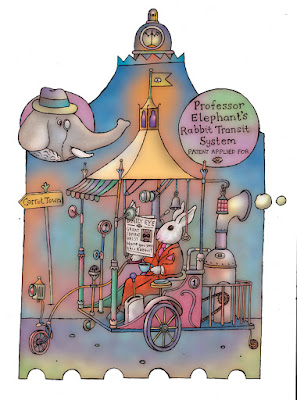
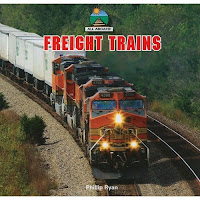



Love!
So excited to be featured on your blog! Love your book!